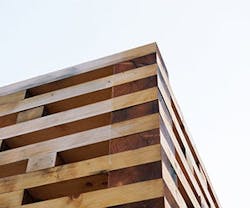Eco-friendly ‘Plyscrapers’ Are Raising the Roof
Imagine if you could construct your building in a way that would save the emissions equivalent to taking 500 gasoline cars off the road for a year.
Envision a reality when your structure inevitably breaks down by the hands of time, you could recycle all of its parts.
As for the wallet—it is cheap, durable and soon to become available to a building managed by you.
Also, one little last detail: it is made entirely out of wood.
Mass timber high-rises, coined “ply-scrapers,” use cross-laminated timber (CLT) made from cheap, sustainable softwood that glue or pin together in layers to create a super-thick plywood. The materials are bolted together in days and require less labor than traditional steel-and-concrete high-rises. One CLT manufacturer mentions that you do not need a master carpenter to put it together, stating plainly, “it literally goes together like a Lego.”
It is engineered to be stronger than concrete. It can resist earthquakes. Flammability may be your first concern for wood-based materials like this. Fortunately, CLT panels are fire-resistant, charring instead of catching on fire like lumber used commonly in log homes.
Plyscrapers are just starting to catch on. In Portland, Oregon, a 12-story tower known locally as “Framework” will debut in 2018, and will serve as a test of the unique system’s viability to keep up with building codes and standards.
And that will be the biggest hurdle: legality. While the argument for CLT-based building construction is evident from an environmental standpoint, the idea still has to overcome regulations that vary from city to city.
In 2015, the USDA awarded $3 million to two projects that won its tall wood demonstration contest, half given to the aforementioned Framework in Portland and the other to a building proposal in New York City—a planned 10-story wooden condominium slated for construction in Manhattan. But it never happened. New York City nixed the project due to regulations stating that no wooden structure can be built over six stories.
It will take an effort from both the building industry and legislators to create a new normal. The benefits of plyscrapers are undeniable, and when national building codes adapt to co-exist alongside them, the sky is the truly the limit.
